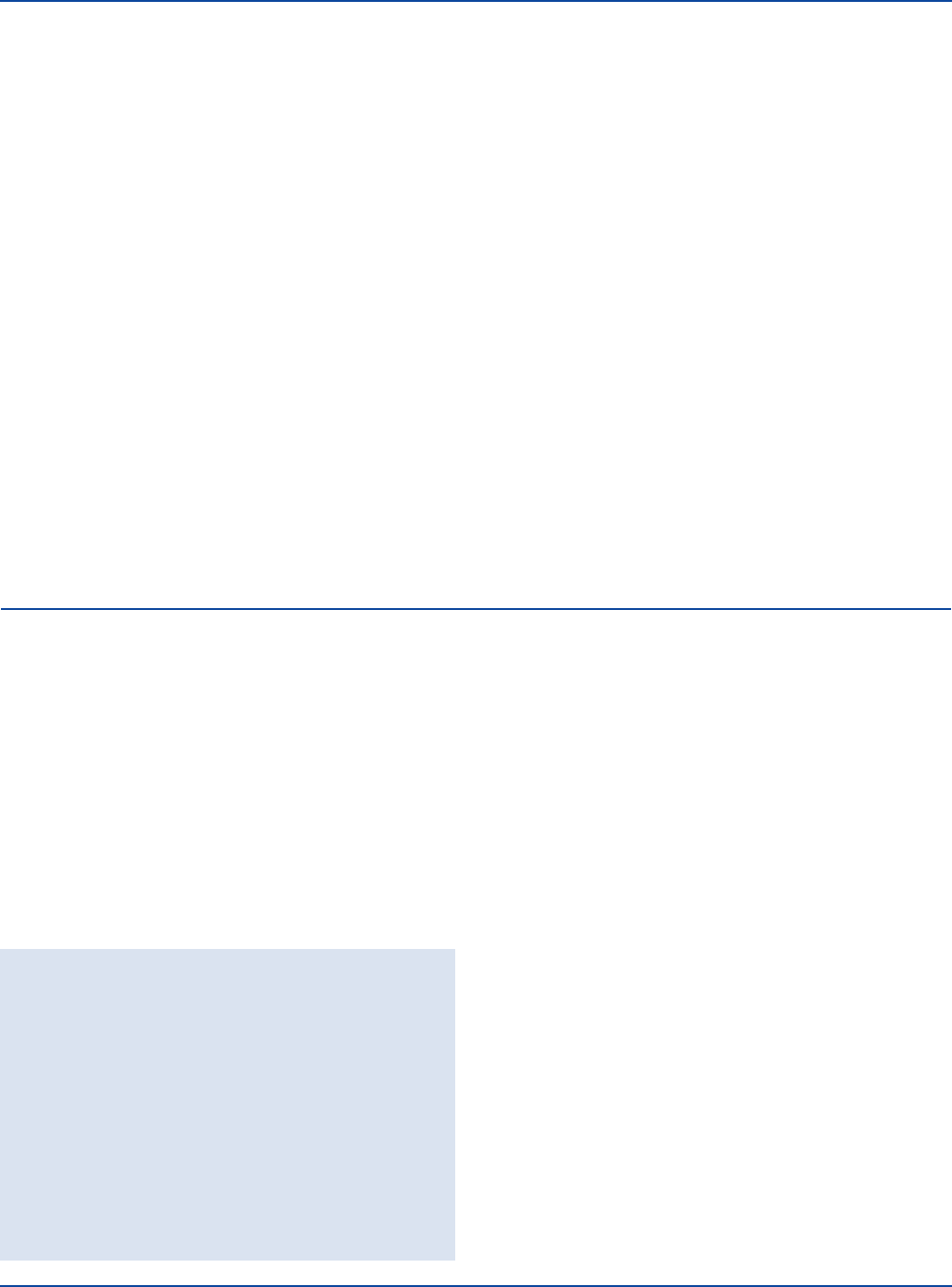BD Diagnostic Systems (publ.). Difco Manual (Manual of Microbiological Culture)
Подождите немного. Документ загружается.


660 The Difco Manual
User Quality Control cont.
SALMONELLA QC ANTIGEN SALMONELLA
ANTISERUM HOMOLOGOUS CONTROL(S)
Poly A-I & Vi A, B, D, E
1
, E
2
, E
4
, F,
G
1
, H, I, Vi
Poly A A, B, D, E
1
, E
2
, E
4
Poly B C
1
, C
2
, F, G
1
, H
Poly C I
Group A Factors 1, 2, 12 A
Group B Factors 1, 4, 5, 12 B
Group B Factors 1, 4, 12, 27 B
Group C
1
Factors 6, 7 C
1
Group C
2
Factors 6, 8 C
2
Group D
1
Factors 1, 9, 12 D
Group E Factors 1, 3, 10, 15, 19, 34 E
1
, E
2
, E
4
Group E
1
Factors 3, 10 E
1
Group E
2
Factors 3, 15 E
2
Group E
4
Factors 1, 3, 19 E
4
Group F Factor 11 F
Group G Factors 13, 22, 23, (36), (37) G
1
Group G
1
Factors 13, 22, (36), (37) G
1
Group H Factors 1, 6, 14, 24, 25 H
Group I Factor 16 I
Vi Vi
Factor 2 A
Factor 4 B
Factors 4, 5 B
Factor 5 B
Factor 7 C
1
Factor 8 C
2
Factor 9 D
Factor 10 E
1
Factor 15 E
2
Factor 19 E
4
Factor 22 G
1
Factor 14 H
Note: Parentheses ( ) indicate that the antigen is poorly developed or
agglutinates weakly. For a complete and current explanation of the
classification of Salmonella, consult appropriate references.
3,4,5
QC Antigens Salmonella Section V
The use of Salmonella antisera in the serological identification of
Salmonella requires the use of quality control test suspensions to
verify that the antisera are performing as expected. Most laboratories
are required to test antisera with positive and negative controls prior
to use.
1,2
QC Antigens Salmonella are designed as homologous
controls for testing the efficacy of the Salmonella grouping antisera
employed in routine laboratory procedures.
Principles of the Procedure
Serological procedures that confirm the identification of an organism
are usually agglutination reactions. Agglutination reactions may be
either homologous or heterologous. Homologous reactions occur
between a microorganism (antigen) and the corresponding antibody.
These reactions occur rapidly and are strong. Heterologous reactions
occur when a microorganism (antigen) reacts with an antibody
produced in response to some other species or serotype. These
reactions occur slowly and are weak.
Heterologous reactions may be unexpected and unpredictable and may
lead to confusion in serological identification. Therefore, only strongly
positive homologous agglutination reactions should be regarded as
significant.
Reagents
HOMOLOGOUS
QC ANTIGEN ORGANISM USED FOR IDENTIFYING
SALMONELLA ANTIGEN PREPARATION ANTIGEN(S)
O Group A S. paratyphi A var. Durazzo, Factors 2, 12 2
O Group B S. typhimurium Factors
1, 4, [5], 12 4, 5
O Group C
1
S. choleraesuis factors 6, 7 7
O Group C
2
S. newport factors 6, 8 8
O Group D S. gallinarum factors
1, 9, 12 9
O Group E
1
S. anatum factors 3, 10 10
O Group E
2
S. newington factors 3, 15 15
O Group E
4
S. senftenberg factors 1, 3, 19 19
O Group F S. rubislaw factor 11 11
O Group G
1
S. poona factors [1], 13, 22, [36], [37] 22
O Group H S. carrau factors 6, 14, 24 14
O Group I S. hvittingfoss factor 16 16
Vi Citrobacter ballerup O29 Vi
Note: Brackets [ ] indicate that the antigen may be absent.
Underlining indicates that the O antigen has been lysogenized in that
strain.
These antigen suspensions are ready to use. QC Antigens Salmonella
O are preserved with 0.5% phenol USP; QC Antigen Salmonella Vi
contains 0.01% Thimerosal. When used as described, each vial of QC
Antigen Salmonella has sufficient reagent for 20 slide tests.
Febrile Negative Control is a lyophilized standard protein solution,
containing approximately 0.04% Thimerosal as a preservative. When
used as described, each vial of Febrile Negative Control has sufficient
reagent for 100 slide tests.
Precautions
1. For In Vitro Diagnostic use.
2. QC Antigens Salmonella
The Packaging of This Product Contains Dry Natural Rubber.
3. Follow proper established laboratory procedure in handling and
disposing of infectious materials.
4. QC Antigens Salmonella are not to be used for immunization of
humans or animals.
Storage
Store QC Antigens Salmonella at 2-8°C.
Store lyophilized and rehydrated Febrile Negative Control at 2-8°C.
Expiration Date
The expiration date applies to the product in its intact container when
stored as directed. Do not use a product if it fails to meet specifications
for identity and performance.

The Difco Manual 661
Section V QC Antigens Salmonella
Procedure
Materials Provided
QC Antigens Salmonella
Febrile Negative Control
Materials Required But Not Provided
Agglutination slides
Applicator sticks
Sterile distilled or deionized water
Reagent Preparation
QC Antigens Salmonella are ready to use.
Equilibrate all materials to room temperature before performing the
tests. Ensure that all glassware and pipettes are clean and free of
residues such as detergents.
Febrile Negative Control: To rehydrate, add 5 ml sterile distilled or
deionized water and rotate gently to completely dissolve the contents.
Before using QC Antigens Salmonella, examine the Salmonella
antisera (Poly, Group or Factor) chosen for use. The antisera must meet
all product specifications.
Test Procedure
1. Positive control: Dispense 1 drop (35 Fl) of the Salmonella
Antiserum to be tested on an agglutination slide. Add 1 drop of
the QC Antigen Salmonella chosen as the positive control and
mix thoroughly.
2. Negative control: Dispense 1 drop of Febrile Negative Control on
the agglutination slide. Add 1 drop of the QC Antigen Salmonella
chosen as the positive control and mix thoroughly.
3. Rotate the slide for 1 minute and read for agglutination. Results
must be read within 1 minute.
Results
1. Read and record results as follows.
4+ 100% agglutination; background is clear to slightly hazy.
3+ 75% agglutination; background is slightly cloudy.
2+ 50% agglutination; background is moderately cloudy.
1+ 25% agglutination; background is cloudy.
– No agglutination.
2. Positive control: Should show 3+ or greater agglutination.
3. Negative control: Should show no agglutination. Rarely, a +/-
reaction is possible.
Limitations of the Procedure
1. Excessive heat from external sources (hot bacteriological loop,
burner flame, light source, etc.) may prevent a smooth suspension
of the microorganism or cause evaporation or precipitation of the
test mixture. False-positive reactions may occur.
2. QC Antigens Salmonella will react with their corresponding
homologous Salmonella polyvalent, group or factor antiserum.
Some single factor antisera may give weaker reactions than poly-
valent or grouping antisera due to specificity of the single factor
antiserum for the identifying antigen(s).
3. The density of QC Antigens Salmonella is adjusted so that they
give negative reactions with heterologous Salmonella Group
Antisera. However, an antiserum may have a particular avidity for
a given factor and agglutinate with another QC Antigen Salmonella
having the common factor. For example, Salmonella O Group E
1
Antiserum Factors 3, 10 will agglutinate QC Antigen Salmonella
O Group E
1
(3, 10) but may also agglutinate QC Antigen
Salmonella O Group E
2
(3, 15) if the antiserum is of high titer for
factor 3.
4. Exposure to temperatures below 2°C can result in autoagglutination.
Antigens must be smooth, uniform suspensions. Examine the antigen
vial for agglutination before use. Suspensions with agglutination
are not usable and should be discarded.
References
1. Murray, P. R., E. J. Baron, M. A. Pfaller, F. C. Tenover, and
R. H. Yolken (ed.). 1995. Manual of clinical microbiology, 6th ed.
American Society for Microbiology, Washington, D. C.
2. Isenberg, H. D. (ed.). 1992. Clinical microbiology procedures
handbook, vol. 1. American Society for Microbiology,
Washington, D. C.
3. Ewing, W. H. (ed.). 1986. Edwards and Ewing’s identification of
Enterobacteriaceae, 4th ed. Elsevier Science Publishing Co., Inc.,
New York, NY.
4. McWhorter-Murlin, A. C., and F. W. Hickman-Brenner. 1994.
Identification and serotyping of Salmonella and an update of the
Kauffmann-White Scheme. U. S. Dept. Health and Human
Services, Public Health Service, Centers for Disease Control and
Prevention, Atlanta, GA.
5. Popoff, M. Y., and L. LeMinor. 1997. Antigenic formulas of the
Salmonella serovars. WHO Collaborating Centre for Reference and
Research on Salmonella. Institut Pasteur, Paris, France.
Packaging
QC Antigen Salmonella O Group A 1 ml 2130-50
QC Antigen Salmonella O Group B 1 ml 2131-50
QC Antigen Salmonella O Group C
1
1 ml 2132-50
QC Antigen Salmonella O Group C
2
1 ml 2133-50
QC Antigen Salmonella O Group D 1 ml 2134-50
QC Antigen Salmonella O Group E
1
1 ml 2135-50
QC Antigen Salmonella O Group E
2
1 ml 2136-50
QC Antigen Salmonella O Group E
4
1 ml 2137-50
QC Antigen Salmonella O Group F 1 ml 2138-50
QC Antigen Salmonella O Group G
1
1 ml 2139-50
QC Antigen Salmonella O Group H 1 ml 2140-50
QC Antigen Salmonella O Group I 1 ml 2141-50
QC Antigen Salmonella Vi 1 ml 2142-50
Febrile Negative Control 5 ml 3239-56

662 The Difco Manual
Bacto
®
QC Antigens Shigella
QC Antigen Shigella Group A
.
QC Antigen Shigella Group A
1
QC Antigen Shigella Group B
.
QC Antigen Shigella Group C
QC Antigen Shigella Group C
1
.
QC Antigen Shigella Group C
2
QC Antigen Shigella Group D
.
QC Antigen Alkalescens-Dispar
Group 1
User Quality Control
Identity Specifications
QC Antigens Shigella
Appearance: Light gray to white suspension.
QC Antigen Alkalescens-Dispar Group 1
Appearance: Light gray to white suspension.
Febrile Negative Control
Lyophilized appearance: Colorless to light gold, button to
powdered cake.
Rehydrated appearance: Colorless to light gold, clear liquid.
Performance Response
Rehydrate Shigella Antiserum Poly and Alkalescens-Dispar
Antiserum Poly per label directions. Perform the slide
agglutination test using an appropriate QC Antigens Shigella
or Alkalescens-Dispar Group 1.
The following chart lists the QC Antigens Shigella or QC
Antigen Alkalescens-Dispar Group 1 recommended as the
homologous (positive) control antigen. The homologous
control antigen has certain identifying antigen(s) in common
with the antiserum.
QC ANTIGEN
ANTISERUM HOMOLOGOUS CONTROL
Shigella Antiserum Poly Group A Shigella Group A
Shigella Antiserum Poly Group A
1
Shigella Group A
1
Shigella Antiserum Poly Group B Shigella Group B
Shigella Antiserum Poly Group C Shigella Group C
Shigella Antiserum Poly Group C
1
Shigella Group C
1
Shigella Antiserum Poly Group C
2
Shigella Group C
2
Shigella Antiserum Poly Group D Shigella Group D
Alkalescens-Dispar Antiserum Poly Alkalescens-Dispar Group 1
Intended Use
Bacto QC Antigens Shigella and Bacto QC Antigen Alkalescens-
Dispar Group 1 are used in the quality control testing of Shigella
Antisera Poly and Alkalescens-Dispar Antiserum Poly by the slide
agglutination test.
Summary and Explanation
Shigella species cause the diarrheal disease known as shigellosis (classic
bacillary dysentery) in humans. The range of illness is from mild
diarrhea to severe dysentery characterized by abdominal cramps and
frequent passage of bloody, mucoid stools. While the disease is usually
self-limiting, it can be life threatening to the young, the elderly and
malnourished persons. Shigella species are carried primarily in humans
and are not generally distributed in nature. While transmission is usually
direct person-to-person or through contaminated water supplies, food
borne outbreaks do occur.
The genus Shigella belongs to the family Enterobacteriaceae. Shigella
are facultatively anaerobic, gram-negative bacilli that typically are
oxidase negative, lactose negative, H
2
S negative and do not produce
gas. Shigella and Escherichia are genetically related. Certain strains of
E. coli may resemble Shigella biochemically because both can be lactose
negative, nonmotile and non-gas-producing. These anaerogenic,
nonmotile types have historically been called the Alkalescens-Dispar
group and are presently classified as E. coli.
1-6
Serological testing with polyvalent and group specific antisera should
be used to confirm the identification of isolates that are morphologically
and biochemically identified as Shigella species. Shigella are nonmotile,
so serological identification is based on somatic (“O”) antigens.
However, some strains have envelope antigens that prevent agglutination
in somatic antisera. Heating the suspension at 100°C for 15-60
minutes destroys these interfering antigens. The four named species or
serotypes of Shigella are S. dysenteriae (10 serovars), S. flexneri (six
serovars), S. boydii (15 serovars) and S. sonnei. For a complete and
current explanation of the classification of Shigella, consult appropriate
references.
1
Shigella Antisera Poly and Alkalescens-Dispar Antiserum Poly are used
in the serological identification of Shigella species and the Alkalescens-
Dispar (A-D) Group. QC Antigens Shigella and Alkalescens-Dispar
Group 1 are designed as positive controls for testing the efficacy of the
Shigella grouping antisera used in laboratory procedures.
QC Antigens Shigella and QC Antigen Alkalescens-Dispar Group 1
may also be used as negative controls by using a heterologous antigen
(possessing no common antigen) with a given test serum. However,
cross reactivity may occur. Consult appropriate references for further
details on cross reactivity.
1
QC Antigens Shigella Section V

The Difco Manual 663
Principles of the Procedure
Serological procedures that confirm the identification of an organism
are usually agglutination reactions. Agglutination reactions may be
either homologous or heterologous. Homologous reactions occur
between a microorganism (antigen) and the corresponding antibody.
These reactions occur rapidly and are strong. Heterologous reactions
occur when a microorganism (antigen) reacts with an antibody
produced in response to another species or serotype. These reactions
occur slowly and are weak.
Heterologous reactions may be unexpected and unpredictable and may
lead to confusion in serological identification. Therefore, only strongly
positive homologous agglutination reactions should be regarded as
significant.
Reagents
QC ANTIGEN ORGANISM IDENTITY
Shigella Group A Shigella dysenteriae type 1
Shigella Group A
1
Shigella dysenteriae type 8
Shigella Group B Shigella flexneri type 6
Shigella Group C Shigella boydii type 3
Shigella Group C
1
Shigella boydii type 8
Shigella Group C
2
Shigella boydii type 12
Shigella Group D Shigella sonnei
Alkalescens-Dispar Group 1 E. coli A-D Group 1
QC Antigens Shigella and QC Antigen Alkalescens-Dispar Group 1
contain killed whole organisms preserved in 0.5% formaldehyde. They
are ready to use.
When used as described, each vial of antigen contains sufficient
reagent for 20 slide tests.
Precautions
1. For In Vitro Diagnostic Use.
2. QC Antigen Shigella Group A
QC Antigen Shigella Group A
1
QC Antigen Shigella Group B
QC Antigen Shigella Group C
QC Antigen Shigella Group C
1
QC Antigen Shigella Group C
2
QC Antigen Shigella Group D
QC Antigen Alkalescens-Dispar Group 1
POSSIBLE RISK OF IRREVERSIBLE EFFECTS. (US) Avoid
contact with skin and eyes. Do not breathe mist. Wear suitable
protective clothing. Keep container tightly closed. TARGET
ORGAN(S): Eyes, Kidneys, Lungs, Skin.
FIRST AID: In case of contact with eyes, rinse immediately with
plenty of water and seek medical advice. After contact with skin,
wash immediately with plenty of water. If inhaled, remove to fresh
air. If not breathing, give artificial respiration. If breathing is diffi-
cult, give oxygen. Seek medical advice. If swallowed seek medical
advice immediately and show this container or label.
The Packaging of This Product Contains Dry Natural Rubber.
3. Follow proper established laboratory procedure in handling and
disposing of infectious materials.
4. QC Antigens Shigella and QC Antigen Alkalescens-Dispar
Group 1 are not to be used for immunization of humans or
animals.
Storage
Store QC Antigens Shigella and QC Antigen Alkalescens-Dispar
Group 1 at 2-8°C. Prolonged exposure of reagents to temperatures other
than those specified is detrimental to the products.
Expiration Date
The expiration date applies to the product in its intact container when
stored as directed. Do not use a product if it fails to meet specifications
for identity and performance.
Procedure
Materials Provided
QC Antigens Shigella
QC Antigen Alkalescens-Dispar Group 1
Materials Required But Not Provided
Febrile Negative Control
Agglutination slides
Applicator sticks
Sterile 0.85% NaCl solution
Reagent Preparation
QC Antigens Shigella and QC Antigen Alkalescens-Dispar Group 1
are ready to use.
Equilibrate all materials to room temperature prior to performing the
tests. Ensure that all glassware and pipettes are clean and free of
residues such as detergents.
Test Procedure
1. Positive control: Dispense 1 drop (35 µl) of the Shigella Antiserum
or Alkalescens-Dispar Antiserum Poly to be tested on an aggluti-
nation slide. Add 1 drop of the appropriate QC Antigen Shigella or
QC Antigen Alkalescens-Dispar Group 1 chosen as the positive
control and mix thoroughly.
2. Negative control: Dispense 1 drop of sterile 0.85% NaCl solution
or Febrile Negative Control on the agglutination slide. Add 1 drop
of the appropriate QC Antigen Shigella or QC Antigen Alkalescens-
Dispar Group 1 and mix thoroughly.
3. Rotate the slide for 1 minute and read for agglutination.
Results
1. Read and record results as follows:
4+ 100% agglutination; background is clear to slightly hazy.
3+ 75% agglutination; background is slightly cloudy.
2+ 50% agglutination; background is moderately cloudy.
1+ 25% agglutination; background is cloudy.
– No agglutination.
2. Positive control: Should show 3+ or greater agglutination.
3. Negative control: Should show no agglutination. Rough reactions
can occur. If so, repeat the test using Febrile Negative Control.
Section V QC Antigens Shigella

664 The Difco Manual
Limitations of the Procedure
1. Excessive heat from external sources (hot bacteriological loop,
burner flame, light source, etc.) may prevent a smooth suspension
of the microorganism or may cause evaporation or precipitation of
the test mixture. False-positive reactions can occur.
2. Exposure to temperatures below 2°C can cause autoagglutination.
Antigens must be smooth uniform suspensions. Examine antigen
vials for agglutination before use. Suspensions with agglutination
are not usable and should be discarded.
3. Allow the QC Antigens, the antisera and all equipment used to be
at room temperature at the time of testing. The test reagents, if
cold, may cause false-negative reactions.
4. Shake the antigen well before use to suspend the organisms.
References
1. Ewing, WH. (ed.). 1986. Edwards and Ewing’s identification of
Enterobacteriaceae, 4th ed. Elsevier Science Publishing Co., Inc.,
New York, NY.
2. Gray, L. D. 1995. Escherichia, Salmonella, Shigella and Yersinia,
p. 450-456. In P. R. Murray, E. J. Baron, M. A. Pfaller, F. C.
Tenover, and R. H. Yolken (ed.), Manual of clinical microbiology,
6th ed. American Society for Microbiology, Washington, D.C.
3. Baron, E. J., L. R. Peterson, and S. M. Finegold. 1994. Bailey &
Scott’s diagnostic microbiology, 9th ed. Mosby-Year Book, Inc.,
St. Louis, MO.
4. Pezzlo, M. (ed.). 1994. Aerobic Bacteriology, p. 1.0.1-1.20.47. In
H. D. Isenberg (ed.), Clinical microbiology procedures handbook,
vol. 1. American Society for Microbiology, Washington, D. C.
5. Andrews, W. H., G. A. June, and P. S. Sherrod. 1995. Shigella,
p. 6.01-6.06. In FDA Bacteriological Analytical Manual, 8th ed.
AOAC International, Gaithersburg, MD.
6. Smith, J. L. 1992. Shigella, p. 423-431. In C. Vanderzant and
D. F. Splittstoesser (eds.), Compendium of methods for the
microbiological examination of foods, 3rd ed. American Public
Health Association, Washington, D.C.
Packaging
QC Antigen Shigella Group A 1 ml 2100-50
QC Antigen Shigella Group A
1
1 ml 2101-50
QC Antigen Shigella Group B 1 ml 2102-50
QC Antigen Shigella Group C 1 ml 2103-50
QC Antigen Shigella Group C
1
1 ml 2104-50
QC Antigen Shigella Group C
2
1 ml 2105-50
QC Antigen Shigella Group D 1 ml 2106-50
QC Antigen Alkalescens-Dispar Group 1 1 ml 2116-50
Febrile Negative Control 5 ml 3239-56
Bacto
®
Salmonella Antisera
Salmonella O Antisera
.
Salmonella H Antisera
.
Salmonella H
Antisera Spicer-Edwards
continued on following page
User Quality Control
Identity Specifications
Salmonella O Antisera
Lyophilized Appearance: Light gold to amber, button to
powdered cake.
Rehydrated appearance: Light gold to amber, clear liquid.
Salmonella H Antisera
Lyophilized Appearance: Light gold to amber, button to
powdered cake.
Rehydrated appearance: Light gold to amber, clear liquid.
Intended Use
Bacto Salmonella O Antisera are used in agglutination tests for the
identification of Salmonella by somatic (O) antigens.
Bacto Salmonella H Antisera are used in tube agglutination tests for
the identification of Salmonella by flagellar (H) antigens.
Bacto Salmonella H Antisera Spicer-Edwards are used in tube
agglutination tests for screening and identifying the most commonly
encountered salmonellae by flagellar (H) antigens.
Summary and Explanation
Salmonella species cause a variety of human diseases called salmonel-
loses. The range of disease is from mild self-limiting gastroenteritis to
more severe forms, possibly with bacteremia or typhoid fever, which
can be life-threatening. Severe disease and bacteremia are associated
primarily with three serovars of S. enterica subsp. enterica
(Cholerasuis, Paratyphi A and Typhi) while most of the other 2,300 or
more strains are associated with gastroenteritis. The severity of the
diarrheal disease depends upon the virulence of the strain and the
condition of the human host.
Salmonella is found in nature and occurs in the intestinal tract of
many animals, both wild and domestic. The microorganism can spread
to man from contact with the environment or from eating meat or
vegetable food products.
Salmonella Antisera Section V

The Difco Manual 665
User Quality Control cont.
Performance Response
Rehydrate Salmonella O, Salmonella Vi, and Salmonella H
Antisera per label directions. Perform the slide agglutination
test using appropriate Salmonella O and Vi Antisera and QC
Antigens Salmonella O Groups A -I and Vi.
The chart below includes the QC Antigens Salmonella O
recommended as homologous (positive) control antigens. (The
homologous control antigen has certain identifying antigen(s)
in common with the antiserum.) For a negative (heterologous)
antigen control, use a QC Antigen Salmonella containing
antigens unrelated to those in the homologous control.
Homologous control: Should show 3+ or greater agglutination.
Negative control: Should show no agglutination. Rarely, a +/–
reaction is possible.
For Salmonella H Antisera, maintain stock cultures of known
serological identification, and prepare antigen positive and
negative controls by using known serotypes and following the
procedure described above in Tube Test Preparation.
QC ANTIGEN SALMONELLA O
SALMONELLA O ANTISERUM HOMOLOGOUS CONTROL
Poly A-I & Vi Groups A,B,C
1
,C
2
,D,E
1
,E
2
,
E
4
,F,G
1
,H,I,Vi
Poly A Groups A,B,D,E
1
,E
2
,E
4
Poly B Groups C
1
,C
2
,F,G
1
,H
Poly C Group I
Group A Factors 1,2,12 Group A
Group B Factors 1,4,5,12 Group B
Group B Factors 1,4,12,27 Group B
Group C1 Factors 6,7 Group C
1
Group C2 Factors 6,8 Group C
2
Group D1 Factors 1,9,12 Group D
Group E Factors 1,3,10,15,19,34 Groups E
1
,E
2
,E
4
Group E1 Factors 3,10 Group E
1
Group E2 Factors 3,15 Group E
2
Group E4 Factors 1,3,19 Group E
4
Group F Factor 11 Group F
Group G Factors 13,22,23,(36),(37) Group G
1
Group G1 Factors 13,22,(36),(37) Group G
1
Group H Factors 1,6,14,24,25 Group H
Group I Factor 16 Group I
Vi Group Vi
Factor 2 Group A
Factor 4 Group B
Factors 4,5 Group B
Factor 5 Group B
Factor 7 Group C
1
Factor 8 Group C
2
Factor 9 Group D
Factor 10 Group E
1
Factor 15 Group E
2
Factor 19 Group E
4
Factor 22 Group G
1
Factor 14 Group H
Note: Parentheses ( ) enclosing the designation for an antigen indicate that
the antigen is poorly developed or agglutinates weakly agglutinates. For a
complete and current explanation of the classification of Salmonella, consult
appropriate references.
1,2,3,8,11
Table 1. Differentiation of the genus Salmonella from other genera.
1
+ 90-100% positive
[+] 76-89% positive
d 26-75% positive
[–] 11-25% positive
– 0-10% positive
All Salmonella serovars belong to two species: S. bongori, which
contains 18 serovars, and S. enterica, which contains the remaining 2,300
or more serovars divided among six subspecies.
2,3
The six subspecies of S. enterica are:
S. enterica subsp. enterica (I or 1)
S. enterica subsp. salamae (II or 2)
S. enterica subsp. arizonae (IIIa or 3a)
S. enterica subsp. diarizonae (IIIb or 3b)
S. enterica subsp. houtenae (IV or 4)
S. enterica subsp. indica (VI or 6)
(The legitimate species name for S. enterica is S. choleraesuis.
However, this name may be confused with the serotype named
“choleraesuis.” At the International Congress for Microbiology in 1986,
the International Subcommittee for Enterobacteriaceae agreed to adopt
the species name, S. enterica.
4
LeMinor and Popoff
5
published a
request to the Judicial Commission to use S. enterica as a species name.
The Commission ruled that S. choleraesuis is the legitimate name.
6,7
S. enterica is used in many countries and is favorably accepted as the
species name.
8,9
The Centers for Disease Control has adopted this
designation until the problem of naming this species is resolved.
2
)
Nomenclature and classification of these bacteria are constantly
changing.
1
Salmonella and the former Arizona should be considered a
single genus, Salmonella.
9
It is recommended that laboratories report
the names of Salmonella serovars for the subspecies enterica. The
serovar names are no longer italicized and the first letter is capitalized.
For example, the strain that used to be identified as Salmonella
typhimurium is now known as Salmonella Typhimurium.
Citrobacter
Test
Salmonella amolonaticus diversus freundii Edwardsiella
Indole production – + + – d
Citrate, Simmons + [+] + + –
H
2
S production + – – [+] d
Urea hydrolysis – [+] d d –
Lysine decarboxylase + – – – +
Ornithine + + + [–] [+]
decarboxylase
D-Adonitol, – – + – –
acid production
L-Arobinose, + + + + –
acid production
L-Rhamnose, + + + + –
acid production
D-Sorbitol, + + + + –
acid production
D-Xylose, + + + + –
acid production
Acetate utilization + [+] [+] [+] –
Section V Salmonella Antisera

666 The Difco Manual
Serovars of other subspecies of S. enterica (except some in the
subspecies salamae and houtenae) and those of S. bongori are not named
and are designated by their antigenic formula. For the most recent
information on nomenclature, consult appropriate references.
1,7,10-13
Results are for 48-hours incubation. Tests were performed at 35-37°C.
Serotypes of Salmonella are defined based on the antigenic structure
of both somatic or cell wall (O) antigens and flagellar (H) antigens.
The antigenic formula lists the O antigen(s) first, followed by the
H antigen(s). The major antigens are separated by colons and the
components of the antigens separated by commas. For example, the
antigenic formula for Salmonella Typhimurium is Salmonella
1,4,5,12:i:1,2. This means that the strain has O antigen factors 1,4,5 and
12, the flagella phase 1 antigen i, and flagella phase 2 antigens 1 and 2.
Complete identification of Salmonella requires cultural isolation,
biochemical characterization and serotyping. However well-defined
the serology of Salmonella, the use of serological procedures does not
supersede cultural isolation and biochemical characterization. Any
serological results obtained before biochemical identification must be
considered as presumptive identification only. Consult to appropriate
references for complete identification of Salmonella.
1,2,3,8,11-14
Characterizing the Serotypes of Salmonella
Salmonella O Antigens: The somatic (O) heat-stable antigens are
identified first. The O antigens are numbered 1-67 using Arabic
numerals. The numbers are not completely continuous because certain
strains were reclassified to other genera and the antigenic Arabic
numbers were deleted from the schema.
Salmonella enterica
subsp. subsp.
enterica
salamae
serovar serovar Serovar serovar Serovar
Test Choleraesuis Gallinarum Paratyphi A Pullorum Typhi
Citrate, + [–] – – – –
Simmons
H
2
S+d+–++
production
Lysine + + + – + +
decarboxylase
Ornithine + + – + + –
decarboxylase
Motility + + – + – +
KCN, growth – – – – – –
Malonate + – – – – –
utilization
D-Glucose, + + – + + –
gas
L-arobinose, + – [+] + + –
acid
Dulcitol, + – + + – –
acid
Lactose, acid – – – – – –
Maltose, acid + + + + – +
Melibiose, – d – + – +
acid
L-Rhamnose, + + – + + –
acid
D-Sorbitol + [+] – + [–] +
Trehalose, + – d + [+] +
acid
D-Xylose, + + d – [+] [+]
acid
Mucate, acid + – d – – –
Tartrate, d [+] + – – +
Jordans
ONPG [–] – – – – –
Table 2a. Differentiation of Salmonella species, subspecies, and
some serovars.
1,2
Table 2b. Differentiation of Salmonella species, subspecies and
some serovars.
1,2
+ 90-100% positive
[+] 76-89% positive
d 26-75% positive
Salmonella enterica
Salmonella
subsp. subsp. subsp. subsp. subsp.
Test bongori
arizonae enterica diaizonae houtenae indica
Citrate, + + + + + [+]
Simmons
H
2
S++++++
production
Lysine + + + + + +
decarboxylase
Ornithine + + + + + +
decarboxylase
Motility + + + + + +
KCN, growth + – – – + –
Malonate – + – + – –
utilization
D-Glucose, [+] + + + + +
gas
L-arobinose, + + + + + +
acid
Dulcitol, + – + – – d
acid
Lactose, acid – [–] – [+] – [–]
Maltose, acid + + + + + +
Melibiose, [+] + + + + [+]
acid
L-Rhamnose, + + + + + +
acid
D-Sorbitol + + + + + –
Trehalose, + + + + + +
acid
D-Xylose, + + + + + +
acid
Mucate, acid + + + d – +
Tartrate, – – + [–] d +
Jordans
ONPG + + – + – D
[–] 11-25% positive
0 10% positive
Salmonella Antisera Section V

The Difco Manual 667
Serogroups represent the organization of Salmonella strains based on
the antigen(s) shared in common and are designated by the letters A-Z.
After exhausting the alphabet, the serogroups were numbered beginning
with No. 51 (the serogroup Z organism having antigen No. 50). While
one somatic antigen identifies each serogroup, certain other antigens
may be shared among several serogroups.
Most organisms contain antigens in common that will cause cross-
reactions in an unabsorbed or “partially absorbed” antiserum. One
somatic antigen identifies a serogroup and is shared in common by
all members of a given serogroup. For example, serogroup A is
represented by three members, Salmonella Paratyphi A (somatic antigens
1,2,12), Salmonella Kiel (somatic antigens 1,2,12), and Salmonella
Nitra (somatic antigens 2,12). All three members of this serogroup
contain antigens 2 and 12 in common. Serogroup B is represented by
many organisms consisting having different combinations of somatic
antigens 1,4,5,12 and 27. Serogroup D organisms contain somatic
antigens 1,9,12, etc.
In the above example, all three serogroups A, B, and D contain
antigens 1 and 12. An antiserum prepared from a 1,2,12 culture, if not
absorbed, will react with cultures of serogroups B and D in varying
degrees depending on the concentration of the commonly shared 1 and
12 factors. This must be taken into consideration when choosing an
antiserum to be used in the examination of the salmonellae.
Several different antisera are available. Some represent group antigens.
Others are single factor sera, which should be used when testing for an
identifiable antigen in a given serogroup. Such a single factor serum is
not called a “group” serum, though it contains the group identifiable
agglutinin. (It has been recommended by the CDC that the term “group”
be applied only to those sera possessing all the major agglutinins found
in that group.)
In unabsorbed antisera, cross-reactions occur if strains sharing some
“like” antigens are tested, even when they are in separate serogroups
based on the major group antigen(s) they possess. Unabsorbed antisera
are available as group antisera containing all factors in that group.
In absorbed antisera, cross reactions are less likely and are weaker.
Absorbed antisera are available as factor specific antisera.
Flagellar Salmonella H Antigens: The flagellar (H) antigens are heat
labile and are usually associated with motility. Cultures are ordinarily
flagellated and actively motile, although flagellated cultures can be
nonmotile. H antigen characterization is done after the serogroup of
the strain is determined. The H antigens of Salmonella are designated
by letters of the alphabet, a-z, followed by z, z
1
, z
2
, etc., and by Arabic
numerals. H antigens exist in 2 phases, phase 1 and phase 2. Phase 1
antigens are expressed in letters a-z, etc., and the phase 2 antigens are
most often expressed in Arabic numerals. Older cultures may express
both phases of a diphasic serotype, but recent clinical isolates more
often express only one phase. Phase reversal may be necessary to
isolate both phases of a diphasic culture. Consult an appropriate
reference for more detailed information.
8
A pure H antiserum cannot be prepared without some somatic content.
However, since H antigens are highly antigenic, the serum derived
from motile cultures may be used at a dilution that reduces somatic
agglutination below the detection level.
Salmonella Vi Antigen: The Vi Antigen is a heat-labile envelope
antigen that may surround a cell wall and mask somatic antigen activity.
Microorganisms having the Vi Antigen will not agglutinate in O antisera.
Using Salmonella Antisera
Salmonella O Antisera: The recommended serological Identification
scheme begins with Salmonella O Antisera Poly A through Poly G,
which contain the following:
SALMONELLA POLY GROUP ANTISERA SOMATIC GROUPS PRESENT
Bacto Salmonella O Antiserum Poly A A,B,D,E
1
,(E
2
,E
3
),*E
4
,L
Bacto Salmonella O Antiserum Poly B C
1
,C
2
,F,G,H
Bacto Salmonella O Antiserum Poly C I,J,K,M,N,O
Bacto Salmonella O Antiserum Poly D P,Q,R,S,T,U
Bacto Salmonella O Antiserum Poly E V,W,X,Y,Z
Bacto Salmonella O Antiserum Poly F 51–55
Bacto Salmonella O Antiserum Poly G 56–61
*Strains of groups E
2
and E
3
are lysogenized by phage 15, then by phage 34.
These strains are now classified into group E
1
.
3
If agglutination occurs, use individual Salmonella O Group Factor
Antisera to determine the specific serogroup to which the isolate
belongs. For efficiency, test first with individual Salmonella O Group
Factor Antisera.
If agglutination does not occur with Poly A or B, test the isolate with
Salmonella O Antiserum Vi. If positive, heat and retest. If agglutination
does not occur with Salmonella O Antiserum Vi, the isolate is not
likely to be Salmonella. Results should be examined. If questions
exist, the isolate should be sent to a reference laboratory.
If agglutination does not occur with Poly C, D, E, F, and G, the isolate
is not likely to be Salmonella.
Table 3. Schema for using Salmonella O Antisera Poly Groups A, B,
C, D, E, F and G.
Salmonella O Antiserum Poly A-I and Vi: This antiserum detects
factors 1-16, 19, 22-25, 34 and Vi. This combination of factors
represents the most frequently isolated Groups A-I and the Vi antigens
and is used to screen possible Salmonella isolates.
A positive reaction indicates that further serological testing is needed
to identify the isolate using Salmonella O Group Factor Antisera. The
most common serogroups are B, D and C
1
. For efficiency, first use
the Salmonella O Group Factor Antisera for these serogroups.
If the isolate is positive with Salmonella O Antiserum Poly A-I and Vi
but negative with Poly A-Poly G, test the isolate with Salmonella Vi
Antiserum. If positive with Salmonella Vi Antiserum, heat and retest
using individual Salmonella O Antisera. If negative with Salmonella
Test with
Salmonella O antisera Poly Groups A, B, C, D, E, F and G
Test Result
+ – with – with
Poly A or B Poly C, D, E,
F and G
Test with
Individual Vi Antiserum
Salmonella O
Antisera
Test Result
+ with one + –
Salmonella O
Antiserum
(required)
Test
Determine the Heat and retest Test isolate Test isolate
Conclusion
Salmonella H with individual is not a is not a
or Next
Antigen Salmonella O Salmonella Salmonella
Action
Antisera
Section V Salmonella Antisera

668 The Difco Manual
Vi Antiserum, the isolate is not likely to be Salmonella. Results
should be examined. If questions exist, the isolate should be sent to a
reference laboratory.
A negative reaction indicates the isolate is not in serogroups A-I. If
the biochemical reactions are consistent with Salmonella, a serogroup
other than A-I is possible. Further testing with antisera for other
serogroup antigens is necessary.
Table 4. Schema for using Salmonella O Antiserum Poly A-I & Vi.
Salmonella O Group Factor Antisera and Single Factor Antisera:
Use selected Salmonella O Group Factor Antisera. Cross reactions may
occur between serogroups that share O antigens. Consider this partial
list of Salmonella O Group Factor Antisera as an example:
Salmonella O Antiserum Group A Factors 1, 2, 12
Salmonella O Antiserum Group B Factors 1, 4, 5, 12
Salmonella O Antiserum Group B Factors 1, 4, 12, 27
Factors 1 and 12 occur in combination with other antigens and may
cause cross-reactions. The strength of the reactions will help in inter-
pretation. Rapidly forming 3+ or greater agglutination indicates a
homologous reactions.
Use selected Salmonella O Factor Antisera. Absorbed antisera specific
for an identifiable antigen in a given serogroup is used to identify the
isolate further. In the example above, Salmonella O Factor Antisera
could be used:
Salmonella O Antiserum Factor 2
Salmonella O Antiserum Factor 4
Salmonella O Antiserum Factors 4, 5
Salmonella O antiserum Factor 5
Polyvalent Salmonella H Antisera: Further identification of a
Salmonella isolate includes the characterization of the flagellar antigens.
Agglutination with the following Polyvalent H Antisera can be done:
SALMONELLA POLY GROUP ANTISERA FLAGELLAR ANTIGENS PRESENT
Salmonella H Antiserum Poly a-z Groups EN,G,L,Z
4
, 1 complexes and
a-k,r-z,z
6
,z
10
,z
29
Salmonella H Antiserum Poly A Groups a,b,c,d,i,z
10
,z
29
Salmonella H Antiserum Poly B Groups eh,en,enx,enz
15
, G complex
Salmonella H Antiserum Poly C Groups k,l,r,y,z,z
4
Salmonella H Antiserum Poly D Groups z
35
,z
36
,z
37
,z
38
,z
39
,z
41
,z
42
Salmonella H Antiserum Poly E 1 complex z
6
Absorbed H antisera specific for single antigens or a complex of
antigens can be used to identify the isolate further.
Unabsorbed and Absorbed Salmonella H Antisera: Complete
identification of a Salmonella isolate involves analysis of phase 1 and
phase 2 antigens using H antisera. For the complex pattern of analysis
and procedures, consult appropriate references.
8
Salmonella H Antisera Spicer-Edwards: Salmonella H Antisera
Spicer-Edwards is used for screening and identifying the most commonly
encountered Salmonella using a combination of polyvalent and single
complex antisera.
Table 5. Identification of Salmonella H using Salmonella H Antisera
Spicer-Edwards.
Table 6. Identification of Salmonella H using Salmonella H Antisera.
* The G complex component of Salmonella H Antisera Spicer-Edwards
1 and 4 reacts with antigens f,g; f,g,s; f,g,t; g,m; g,m,q; g,m,s; g,m,s,t;
g,m,t; g,p; g,p,s; g,p,u; g,q; g,s,t; g,t; m,p,t,u; and m,t.
** The Z
4
Complex component reacts with z
4
,z
23
; z
4
,z
24
; and z
4
, z
32
.
Note that no antigen is positive with all four Salmonella H Antisera
Spicer-Edwards Any antigen that reacts with all four sera should be
checked for smoothness.
Salmonella Antisera Section V
Test with
Salmonella O Antisera Poly A-I and Vi
Test Result
+–
Test with
Individual Salmonella O Antisera
Test Result
+–
Test with
Salmonella Vi Antiserum
Test Result
+–
Test
Determine the Heat and retest Test isolate May be a
Conclusion
Salmonella H with individual is not a Salmonella
or Next
Antigen Salmonella O Salmonella detectable
Action
Antisera by use of
Salmonella
O Antisera
Poly C, D,
E, F or G
Salmonella H Antisera
Spicer-Edwards
H Antigen(s) 1 2 3 4
a+++–
b++–+
c++––
d+–++
e,h + + + –
G Complex* + – – +
i + –––
k – +++
r–+–+
y–+––
z––++
Z
4
Complex** – – + –
z
10
–––+
z
29
–++–
H Antigen(s) Salmonella H Antisera
e,n,x, EN Complex
e,n,z
15
I,v
I,w L Complex
I,z
13
I,z
28
1,2
1,5 1 Complex
1,6
1,7

The Difco Manual 669
Extent of Serological Identification Necessary
Complete serological characterization of Salmonella is not required
for successful detection of the microorganism when it occurs as a
pathogen. The use of adequate isolation procedures and differential
biochemical tests is of primary importance. Possible Salmonella iso-
lates can be presumptively identified with a minimum of serological
identification. Isolates can be sent to laboratories that perform the level
of testing necessary to completely identify the microorganism.
For a further discussion of the serological identification of Salmonella,
consult appropriate references.
1,2,3,8,11
Principles of the Procedure
Identification of Salmonella species includes both biochemical and
serological identification. Serological confirmation involves the
procedure in which the microorganism (antigen), reacts with its
corresponding antibody. This in vitro reaction produces macroscopic
clumping called agglutination. The desired homologous reaction is
rapid, does not dissociate (high avidity) and bonds strongly (high affinity).
Because a microorganism (antigen) may agglutinate with an antibody
produced in response to another species, heterologous reactions are
possible. These are characterized as weak in strength or slow in
formation. Such unexpected and perhaps unpredictable reactions may
lead to some confusion in serological identification. Therefore, a
positive homologous agglutination reaction should support the
morphological and biochemical identification of the microorganism.
Agglutination of the somatic antigen in the slide test appears as a firm
granular clumping. Homologous reactions are rapid and strong (3+).
Heterologous reactions are slow and weak.
Agglutination of the flagellar antigens in the tube test appears as a
loose flocculation that can easily be resuspended.
Reagents
Salmonella O, H, and Vi Antisera are lyophilized, polyclonal rabbit
antisera containing approximately 0.04% Thimerosal as a preservative.
Salmonella O Poly Antisera are polyvalent antisera. Each antiserum
is specific for certain serogroup antigens. When properly rehydrated
and used as recommended, each vial of Salmonella O or Vi Antisera
contains sufficient reagent for 60 tests. Salmonella O Antisera Poly
A-I and Vi is prepared with representative strains of these serogroups
and is not absorbed. It may cross-react with other antisera because of
shared common O antigens.
Salmonella O Group Antisera are specific for the major factors present
in the serogroup. Salmonella O Factor Antisera are specific for the
factors of the individual serogroups. When using Salmonella O Group
Antisera, cross-reactions are possible because serogroups may share
non-major group antigens. Salmonella O Factor Antisera are absorbed
as necessary to render each antiserum as specific as practical without
reducing the homologous reactions to an unsatisfactory level.
Salmonella H Poly Antisera are polyvalent antisera. Each antiserum
is specific for certain flagellar antigens. Each vial of Salmonella H
Antiserum contains sufficient reagent to perform between 150-1500
tests, depending on the antiserum used. Salmonella H Antisera are
either absorbed or unabsorbed specifically for either phase 1 or phase 2
antigens. Salmonella H Antisera Spicer-Edwards are pooled, polyva-
lent antisera and additional adjunctive antisera to identify the more
commonly occurring H antigens.
Precautions
1. For In Vitro Diagnostic Use.
2. The Packaging of This Product Contains Dry Natural Rubber.
3. Follow proper established laboratory procedure in handling and
disposing of infectious materials.
Storage
Store lyophilized and rehydrated Salmonella O, H and Vi antisera
at 2-8°C.
Prolonged exposure of reagents to temperatures other than those
specified is detrimental to the products. Discard any antiserum that
becomes cloudy during storage.
Expiration Date
The expiration date applies to the product in its intact container when
stored as directed. Do not use a product if it fails to meet specifications
for identity and performance.
Procedure
Materials Provided
Salmonella O Antisera
Salmonella H Antisera
Salmonella Vi Antiserum
(See Packaging.)
Materials Required But Not Provided
Slide Test
0.85% NaCl solution, sterile
Agglutination slides with 1 inch squares
Applicator sticks
Boiling waterbath
Centrifuge
QC Antigens Salmonella
Tube Test
0.85% NaCl solution, sterile
Culture tubes, 12 x 75 mm, and rack
Waterbath, 50 ± 2°C
Serological pipettes, 1 ml
Formaldehyde
Reagent Preparation
Equilibrate all materials to room temperature prior to performing the
tests. Ensure that all glassware and pipettes are clean and free of
residues such as detergents.
Salmonella O, H and Vi Antisera: To rehydrate, add 3 ml of sterile
0.85% NaCl solution and rotate gently to completely dissolve the
contents. Rehydrated antisera are considered a 1:2 dilution. Subsequent
Salmonella O Antisera dilutions are based on this as a starting dilution.
The H antisera are further diluted for use.
Specimen Collection and Preparation
Clinical specimens: Salmonella can be recovered from selective
differential media such as Hektoen Enteric Agar or XLD agar. For
specific recommendations, consult appropriate references.
11,12
Deter-
mine that a pure culture of the microorganism has been obtained and
Section V Salmonella Antisera
